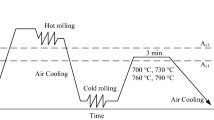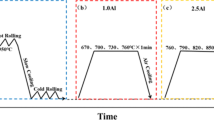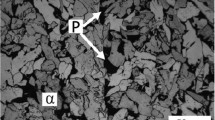Abstract
The effect of adding aluminum and silicon to 35XH1M2ΦA steel is investigated in order to analyze the influence of those elements on austenite formation. 35XH1M2ΦA steel, which is used in heavy industry and in power equipment, is selected for study because its mechanical properties—in particular, its plasticity and impact strength—require improvement. High-temperature structural analysis provides data regarding the ratio of α and γ phases in the steel. On the basis of the results, the critical points Ac 1 and Ac 3 are calculated. It is found that introducing aluminum in 35XH1M2ΦA steel expands the intercritical temperature range, whereas introducing silicon shifts the intercritical temperature range to higher temperatures. The lattice parameter of austenite is least at 740°C in 35XH1M2ΦA steel. Silicon and aluminum raise this temperature to 760 and 780°C, respectively.
Similar content being viewed by others
References
Gervas’ev, M.A. and Kut’in, A.B., Khladostoikie stali dlya krupnykh pokovok i otlivok (Low-Temperature Steel for Large Forgings and Castings), Yekaterinburg: UrO RAN, 2010.
Belikov, S.V., Sergeeva, K.I., Kornienko, O.Yu., et al., Structure formation and properties of steel with heterogeneous bainite–martensite structure for gas and oil pipelines, Metallov. Term. Obrab. Met., 2010, no. 12, pp. 9–14.
Khotinov, V.A., Oshchukov, S.V., and Farber, V.M., Structure and mechanical properties of moderate-carbon steel after heating in the intercritical temperature range, Metallov. Term. Obrab. Met., 2011, no. 11, pp. 31–35.
Kudryashova, O.V., Gervas’ev, M.A., and Khudorozhkova, Yu.V., Structure and properties of moderate-carbon Cr–Ni–Mo steel with added Si and Al after quenching from the two-phase region, Fund. Issled., 2013, no. 4–3, pp. 580–585.
Nouri, A., Saghafian, H., and Kheirandish, S., Effects of silicon content and intercritical annealing on manganese partitioning in dual phase steels, J. Iron Steel Res. Intern, 2010, vol. 17, issue 5, pp. 44–50.
Bhadeshia, H.K.D.H. and Edmonds, D.V., Bainite in silicon steels: New composite-property approach. Part 1, Metal Sci., 1983, no. 17, pp. 420–425.
Gervas’ev, M.A., Maslova, O.V., Illarionova, S.M., et al., Kinetics of bainitic transformation in Cr–Ni–Mo steel with added aluminum and silicon, Izv. Vyssh. Uchebn. Zaved., Chern. Metall., 2014, no. 7, pp. 57–60.
Author information
Authors and Affiliations
Corresponding author
Additional information
Original Russian Text © M.A. Gervas’ev, A.S. Yurovskikh, S.V. Belikov, O.V. Maslova, A.S. Zhilin, 2015, published in “Izvestiya VUZ. Chernaya Metallurgiya,” 2015, No. 9, pp. 677–681.
About this article
Cite this article
Gervas’ev, M.A., Yurovskikh, A.S., Belikov, S.V. et al. Influence of Al and Si on austenite formation in Cr–Ni–Mo steel in the intercritical temperature range. Steel Transl. 45, 658–661 (2015). https://doi.org/10.3103/S0967091215090065
Received:
Published:
Issue Date:
DOI: https://doi.org/10.3103/S0967091215090065




